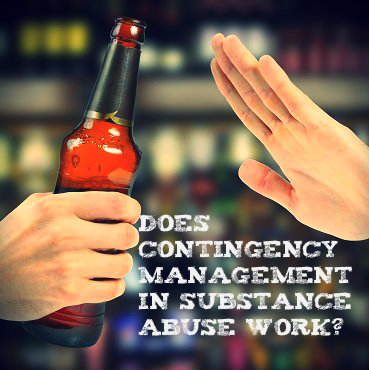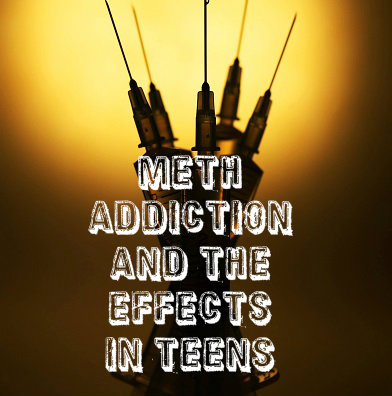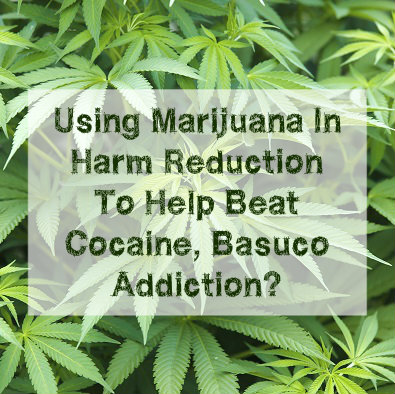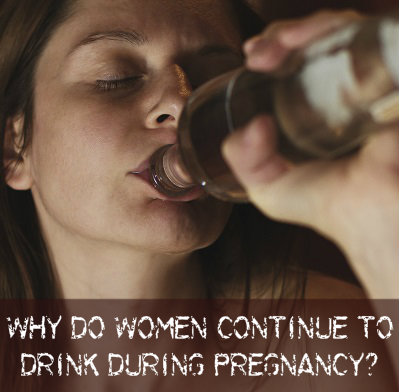Choosing the right alcohol or drug rehab treatment strategy can be a challenge for someone still struggling with addiction. One of the most confusing aspects for many is simply figuring out which therapy does what. It’s critical information because it will guide you toward making the best decisions regarding treatment. This article will help you understand the treatment approach known as contingency management (CM) and how it helps addicts during recovery.
Contingency Management Basics
 Contingency management is based on a simple principle: behavior that is rewarded is behavior more likely to be repeated in the future. It’s a principle we see all the time in everyday life. For example, a teen may earn an allowance for taking on extra chores, or a boss may award her employees with bonuses for excellent performance.
Contingency management is based on a simple principle: behavior that is rewarded is behavior more likely to be repeated in the future. It’s a principle we see all the time in everyday life. For example, a teen may earn an allowance for taking on extra chores, or a boss may award her employees with bonuses for excellent performance.
Although it can be used to treat alcohol abuse, CM is most commonly employed as to treat drug abuse and addiction. The therapy is also used by health professionals to help people overcome a range of challenges, including weight loss, exercise motivation, and cigarette smoking. Additionally, contingency management is sometimes utilized to increase the likelihood a patient will take medication as directed.
How Exactly Is CM Used In Substance Abuse Treatment?
During substance abuse treatment, CM reinforces positive, drug-free behavior with explicit, tangible rewards. One of the most common ways to use this reinforcement is to allow addicts to earn vouchers for goods and services, like movie tickets, retail goods, sports equipment, or electronics, after they’ve submitted a specified number of drug-free urine samples. In some programs, the reward has a fixed dollar amount, such as $25. Other treatment plan rewards may increase in value the longer the drug abuser stays clean. For example, a voucher may hold a starting value of $10 and increase by $2 for each negative sample the addict provides. The goal is to encourage substance abusers to remain abstinent during outpatient treatment.
Why CM Promotes Healthy Behaviors In Addicts
In addition to promoting abstinence, CM can be used to promote other healthy behaviors in addicts. Addiction therapists may reward patients for attending a certain number of 12-step meetings or showing positive behaviors during drug rehab treatment. One program offered housing and behavioral treatment to homeless cocaine addicts in exchange for staying drug-free [1].
Another form of contingency management involves medication for methadone patients. Recovering addicts may be permitted to take methadone doses home if they increase positive behaviors or cease negative ones. A patient, for instance, could earn the right to take home one dose a week after submitting a specific number of drug-negative urine tests.
Contingency management can be an appropriate treatment for many addicts, however, it’s considered especially helpful for those in high-risk groups. For example, this drug rehab treatment has been used to reduce dangerous injection-related behaviors, which increase the risk of acquiring HIV and other bloodborne diseases [2]. CM has also been used successfully to treat pregnant women with addiction. One review of numerous studies concluded that contingency management was more effective at keeping pregnant women in drug treatment than motivational interviewing, another addiction therapy [3].
Effectiveness Of Contingency Management For Drug Abuse
Contingency management has proved to be an effective treatment for substance abuse disorders. One review of 47 studies found that incorporating it into treatment improved drug abstinence rates during recovery. However, it also suggested that contingency management may be more effective for those with opiate or cocaine addiction than for those with multiple drug addictions [4].
Research also suggests CM is useful for keeping addicts in outpatient therapy. Typically, many substance abuse patients miss scheduled appointments; one estimate puts the number as high as 60%. However, in one study, researchers gave addicts who attended scheduled group therapy the chance to draw from a prize bowl, which contained vouchers for prizes ranging from $1 to DVD players. Recovering addicts were more likely to attend weekly sessions when reinforced with contingency management than when they were not [5]. Another study discovered that 84% of outpatient substance abusers receiving vouchers stayed in treatment over 8 weeks, while only 22% of non-voucher patients did so [6].
Contingency Management Drug Addiction Treatment Plan
Like many drug rehab treatment options, CM is not intended to be used as a sole therapy. It’s often used in conjunction with other addiction treatments. For example, cognitive-behavioral therapy (CBT) is one approach a therapist could pair with contingency management. During CBT, the alcoholic or drug addict will identify the negative behaviors and emotions that contribute to addiction.
The cost of contingency management can prevent some substance abuse clinics from using this therapy. Some evidence suggests that CM is not as effective when the value of the vouchers is too low [7]. The cost of vouchers attractive enough to change addiction behavior can quickly add up. In one study, addicts received vouchers worth more than $1,000 over the course of treatment [8].
Some experts have raised concerns that incentives, such as those that allow substance abusers the opportunity to draw a random prize from a bowl, increase the risk for pathological gambling. However, prize drawings in CM have not been shown to promote excessive gambling, according to the National Institute on Drug Abuse [9].
Critics Of Contingency Management For Drug Rehab Treatment
Contingency management is not without critics. Some opponents of this approach assert that contingency management amounts to bribing drug users to stay clean. Another concern of critics is that some addicts will deceive treatment professionals by providing clean urine samples that do not belong to them, thus collecting the incentive without meeting their own obligation to stay abstinent. Additionally, those against this approach argue that CM does not directly address underlying issues that contribute to substance abuse. However, it’s important to note that contingency management is often paired with other treatments developed to produce long-term behavioral changes.
Drug rehab treatment may be one of the most important decisions you’ll ever make. Speak with an addiction professional to learn if contingency management is the right choice for you.
References:
[1] http://www.sciencedirect.com/science/article/pii/S0376871600800083
[2] http://www.ncbi.nlm.nih.gov/pmc/articles/PMC2271179/
[3] http://www.ncbi.nlm.nih.gov/pubmed/17943878
[4] http://onlinelibrary.wiley.com/doi/10.1111/j.1360-0443.2006.01581.x/abstract
[5] http://www.ncbi.nlm.nih.gov/pmc/articles/PMC2606605/
[6] http://psycnet.apa.org/journals/ccp/68/2/250/
[7] http://www.ncbi.nlm.nih.gov/pubmed/16445548
[8] http://ajp.psychiatryonline.org/article.aspx?articleID=174754
[9] http://www.drugabuse.gov/publications/principles-drug-addiction-treatment-research-based-guide-third-edition/evidence-based-approaches-to-drug-addiction-treatment/behavioral-0
13 Nov 2013
Why Is Drug Use Surging In Baby Boomers?
Statistics gathered by the Substance Abuse and Mental Health Services Administration, or SAMHSA, show a disturbing trend among older Americans. Members of the Baby Boom generation are using drugs and getting addicted to them in record numbers. Whether we can explain the trend or not, the fact remains that elder drug abuse presents some unique problems that require unique approaches for prevention and treatment.
 The statistics from SAMHSA show that among older Americans in recent years, marijuana use has increased five-fold, cocaine use has quadrupled, heroin abuse has doubled, and abuse of prescription drugs has more than quadrupled. The survey from SAMHSA also records treatment for drug abuse and addiction and found increases in the numbers of Boomers getting help for alcohol abuse in combination with cocaine use, and for abusing prescription painkillers. Emergency room visits for painkiller abuse and overdoses increased greatly over the last decade.
The statistics from SAMHSA show that among older Americans in recent years, marijuana use has increased five-fold, cocaine use has quadrupled, heroin abuse has doubled, and abuse of prescription drugs has more than quadrupled. The survey from SAMHSA also records treatment for drug abuse and addiction and found increases in the numbers of Boomers getting help for alcohol abuse in combination with cocaine use, and for abusing prescription painkillers. Emergency room visits for painkiller abuse and overdoses increased greatly over the last decade.
Explanations And Complications Of Drug Abuse In Older Americans
At first glance, the statistics surrounding the use and abuse of drugs in older Americans seems surprising. However, it is important to understand that we are discussing a generation of people who came of age in the 1960s, a time of experimentation and rebellion against authority. In tracking the drug and alcohol behaviors of this generation over the years, finding that they now, in their older years, are still using drugs is not a surprise. It only seems shocking when compared with the generations that came before them.
Unfortunately, drug abuse is even more of a problem for a person in his 50s and 60s than it was when he was in his 20s. As we age, our metabolism slows. For an older person abusing drugs or drinking too much alcohol, the time it takes to metabolize and get out of his system is much longer. An older person using may be intoxicated for longer and, therefore, at risk for more accidents and injuries.
Another issue is that drug users in their 50s or 60s are more likely to have health problems than they did in their younger years. Drug or alcohol abuse may exacerbate these problems, or even interact badly with prescribed medications. Furthermore, the symptoms of these other health conditions may mask the usual signs of drug abuse or addiction.
Signs Of Drug Abuse
Drug abuse and addiction are serious problems at any age, but in older Americans they present greater risks and complications. It is important to be aware of the possibility of drug use and to look out for signs in loved ones. Because another health problem may cause symptoms that mask the physical signs of drug abuse, watch for changes in behavior as the sign of a problem. Mood swings that are unexplained could be a sign of addiction, drinking or drug abuse. Changes in personality are also troubling. When someone just doesn’t seem like himself anymore, there could be a problem with drug abuse.
Prescription abuse is a growing problem among all age groups, so look for signs that your older friend or family member is abusing them. This could mean that he is requesting more refills for painkillers, seeing several doctors to get more prescriptions, going to more than one pharmacy or in other ways is trying to get more of his medications than has been prescribed.
Getting Help For A Loved One Abusing Drugs Or Alcohol
If anyone you love or care about is abusing drugs or alcohol, it is important to help him seek treatment; with an older person, it is especially imperative. Drug abuse can cause even more problems for someone who is older and should be stopped in its tracks. Having the courage to confront your parent, spouse, or other loved one about your suspicions could just save his life.
Confrontation is never easy so be prepared. Bring one or two other people along, friends or family members your loved one trusts. Be ready with solutions so that you are not simply accusing, but helping. Do your research ahead of time and find facilities for treatment that are prepared to work with older patients. As the problem of drug abuse continues to rise in the older demographic, more treatment centers are focusing on the age group. You should be able to find treatment plans that will suit the specific needs of your loved one and that will help him feel comfortable while getting well.
12 Nov 2013
Jimmy Choo Co-Founder, Tamara Mellon’s Personal Story On Addiction, Sobriety And Success
It’s easy to fall into the trap of thinking that substance addiction is an endless cycle that determines a person’s future. However, the reality paints a much brighter picture. For many, the act of conquering addiction is only the first step toward a happy and successful life. A recent example of this is the success story of Jimmy Choo founder Tamara Mellon, which illustrates the limitless possibilities of an addict’s life after overcoming addiction.
Tamara Mellon’s Rise From Rock Bottom

Courtesy of: luxsure.com
In her recently published memoir, “In My Shoes,” shoe fashion diva Mellon speaks openly and candidly about her troubled childhood, reckless partying and subsequent substance abuse that ruled much of her early life and career. Mellon was your classic binge drinker who suffered from a cocaine addiction. “One glass of red wine would turn into … calling my coke dealer at 6:00 in the morning” Mellon reports in an NBC Today interview. And as a member of London’s social-elite, Tamara had too-easy access to the club scene that fostered her habits.
Everything shifted in the span of only a couple of days, however, when Mellon was suddenly fired from her job at Vogue magazine and soon after urged by a friend to seek treatment (that moment was the first time, Mellon admits, that she realized that she had a substance abuse problem). The editor’s decision to fire her, Mellon explains, helped set “forces in motion that, in time, would lead to success far beyond anything I could ever have imagined.” Mellon’s recovery is a rocky one, as outlined in her memoir, but she manages to conquer it, a move that led her to develop the influential and extremely successful Jimmy Choo designer shoe label that led her to the top of the fashion industry.
History On Jimmy Choo
Founded in 1996, the J. Choo Limited label has become synonymous with the height of London’s fashion scene. It began as a partnership between Mellon, who focused on developing the brand since leaving rehab, and Jimmy Choo, a shoe designer and cobbler who made his living making shoes for celebrities and royalty, including Princess Diana. With the financial help of her father, Tom Yeardye, Mellon forged a partnership with Choo and launched the shoe line. It’s worth noting that while the line is named after Jimmy Choo, the shoes themselves were made—not designed—by him, but rather designed by Mellon herself and Choo’s niece, Sandra Choi.
Currently, the Jimmy Choo line is considered to be a shoe empire worth just under $1 billion U.S. dollars, with over 100 boutique shops in 32 different countries. The J. Choo Limited designer shoes have made appearances in Hollywood on the red carpet and on screen, including the hit show “Sex and the City.”
Jimmy Choo himself, whom the company is named after, was bought out in spring of 2001 by Equinox Luxury Holdings Ltd. And while Mellon stayed with the company for another decade, she too left in 2011 to start another shoe label, this time under her own name “Tamara Mellon.” Today, J. Choo Limited is operated by chief creative officer Sandra Choi, Jimmy Choo’s niece and former apprentice.
Mellon’s Family Struggle With Alcoholism
As is the case with many people, Mellon’s substance abuse and addiction began at home. Born and reared in London’s upper-class society, Mellon still describes much of her upbringing as “anything but glamorous.” In her memoir, Mellon reports that her mother was a “raging alcoholic,” prone to fits of rage and, like most alcoholics, displayed unpredictable behavior.
The pattern of drug abuse and addiction often runs in families, regardless of their social status, and Mellon is a good example of this. Parents play a central role in their children’s lives, and by extension, their substance addictions do too. In fact, the American Academy of Child and Adolescent Psychiatry (AACAP) reports that children of alcoholics are more than four times as likely to become alcoholics themselves as children of sober parents. Numerous factors play into this, including a greater chance of experiencing neglect or physical abuse (abuse that Mellon experienced firsthand as a young child), and a greater chance of developing emotional problems, including depression, aggression and isolation. In addition, the shame and denial of alcoholism often prevents parents from confronting their children when they begin to abuse drugs themselves.
Like with many of Mellon’s personal and business actions, the publishing of “In My Shoes,” as well as the launch of the Tamara Mellon line, is surrounded by controversy. Some accuse her of sensationalism, while others cast doubt on her ability to build another shoe empire. Mellon however, remains unfazed; after all, she has already faced and conquered the demon of substance addiction—a huge accomplishment on its own. There is no doubt, however, that Mellon’s life is a real success story, and her success and zest for life is due, she says, to overcoming everything that life has thrown at her.
Says Mellon: “I fought my way through the rites of passage.”
11 Nov 2013
Meth Addiction And The Effects In Teens
Fans of the hit crime drama Breaking Bad may have become familiar with the dangers of methamphetamine use. However, as a parent, you may have questions about methamphetamine abuse in teenagers and whether it requires drug rehab treatment. Surveys suggest that 2 to 3.5% of adolescents have used methamphetamines [1]. Also called “speed” or “glass”, it’s a highly addictive stimulant.
How Meth Works
Methamphetamine – or “meth” for short – is a type of amphetamine, a drug that acts on the body’s central nervous system. The drug works by increasing dopamine levels within the brain to very high levels. Dopamine is the brain chemical that’s linked to pleasure, reward, motivation, and also motor function. When dopamine levels skyrocket, as they do during meth use, the user experiences a pleasurable rush that is often compared to euphoria.
While there are several types of amphetamines, meth is generally considered the most potent. The drug can be snorted, injected, or taken orally. Some abusers use a method called parachuting, which involves crushing a pill and then rolling the powder into a piece of tissue or toilet paper. The entire package – tissue and all – is then swallowed, delivering what’s believed to be a stronger, faster high because the pill’s outer protective layer has been destroyed.
 Teen meth addicts will typically use daily or nearly daily. Addiction requiring drug rehab treatment can develop quickly, sometimes within just a few uses. Chronic abuse of the drug leads to tolerance. As one’s tolerance level increases so does the amount of the drug that’s needed in order to achieve the euphoric high.
Teen meth addicts will typically use daily or nearly daily. Addiction requiring drug rehab treatment can develop quickly, sometimes within just a few uses. Chronic abuse of the drug leads to tolerance. As one’s tolerance level increases so does the amount of the drug that’s needed in order to achieve the euphoric high.
Effects Of Meth
Since meth is a stimulant, like cocaine, a teen will experience immediate physical effects, even when the drug is taken in small amounts. Meth users experience increased heart rate and respiration, irregular heartbeat, high body temperature, decreased appetite, inability to sleep, and increased physical activity.
An adolescent with a long-term meth addiction can experience more serious effects. Anxiety, confusion, and extreme weight loss are common. Many develop severe dental problems, such as tooth decay and loss, because the drug reduces output of saliva, which normally protects the mouth, and drug users often have poor dental hygiene.
Teen meth addicts are also at risk because the drug enhances the sex drive. Several studies have found that youth, especially females, who use meth are more likely to engage in risky sexual behaviors [2]. This potentially leads to unsafe sexual practices, including having sex without protection. Research has found a strong association between meth users and sexual risk-taking. A study of adults using meth found they were 1.7 times more likely to have gonorrhea and twice as likely to have chlamydia [3].
Chronic methamphetamine abusers might experience serious psychotic symptoms, including hallucinations, delusions, or paranoia. This can lead to physical problems as well. For instance, a meth user might scratch and gouge at their skin to remove “bugs.” Auditory hallucinations can be particularly dangerous if the addict believes “voices” are commanding him or her to harm others, a symptom that makes drug rehab treatment that much more important.
Meth use in teens can also cause permanent brain damage. Research shows that chronic use causes structural and functional changes to brain areas linked to memory and mood [4, 5]. In addition, brain imaging has shown that meth use changes the dopamine system in a way that reduces verbal learning and motor skills [6]. Using the drug over time also disrupts the body’s normal production of dopamine; as a result, chronic users show severe mood swings.
Signs Of Meth Abuse In Teens
- Euphoric moods (may appear unusually happy)
- Paranoia
- Reduced appetite
- Incessant talking
- Rapid weight loss
- Dilated pupils
- Dry, itchy skin
- Skin sores
- Intense mood swings
- Anxiety, nervousness
- Shaky hands
- Violent or aggressive behavior
- Excessive sweating
Symptoms can become worse as a teen’s meth addiction deepens. For instance, a meth addict often appears undernourished or even sick. He or she may have frequent mood swings, abruptly switching from chatty and friendly one moment to aggressive and hostile the next.
Treatment For Meth Addiction
Due to the serious short-term and long-term health risks, including brain damage and even death, meth addiction in adolescents requires immediate drug rehab treatment. Meth abusers can experience intense withdrawal symptoms, including severe agitation, anxiety, sleeplessness, and strong urges to use. Since withdrawal symptoms can be so powerful, teens should detox in a treatment center where they can be medically monitored.
After the drug is out of the body, your teen will start a treatment plan that will likely have several components based on his or her needs. Currently, there are no approved medications to treat methamphetamine addiction. However, rehab centers have a number of therapies for helping adolescents recover. For example, an addictions specialist may recommend cognitive behavioral therapy. This particular type of therapy helps teens learn more about the factors, such as negative emotions, irrational thoughts, or unhealthy behaviors, that contribute to their drug use. This therapy also teaches them how to deal with those factors in a drug-free way. Contingency management may also be beneficial in a drug treatment program. It provides tangible incentives, such as movie tickets or cash, for drug-free urine samples.
Alternate Therapies For Addiction
Other therapies may help your teen as well. For example, animal-assisted therapy, which involves the use of animals like dogs or horses, can be especially powerful. This treatment approach can help addicted teens reduce anxiety, build self-confidence, and develop trust. Talk with an addiction specialist to learn more about the benefits of animal-assisted therapy.
Family education and counseling will also be essential for guiding your teen through recovery. Educational sessions help parents and family members better understand the nature of addiction. They also show ways to help an addicted teen stay free of drugs. In family counseling, a therapist works with family members to pinpoint and resolve conflicts and communication issues, including those that have played a role in your teen’s decision to use drugs. Family therapy can play an important role in helping your teen avoid a relapse down the road.
Meth Affects The Brain’s Pleasure Center Long After Use
Treating an addiction to meth is challenging, in part, because the brain’s ability to produce dopamine is hampered for up to 6 months or more after drug use stops. As a result, addicts may be unable to experience pleasure. This can make it difficult for them to find enjoyment in even simple activities like spending time with friends, seeing a movie, or relaxing on the beach. This lack of positive emotion can compel many teens to start using again, just so they can feel some form of pleasure.
Yet, despite the challenges, adolescents can fully recover from a methamphetamine addiction. If you suspect or know that your teen is abusing meth, consult a drug rehab treatment as soon as possible – preferably one that is skilled in handling meth abuse and addiction in teens. The staff will work with you to lay out a plan for recovery that gives your teen the best chance for success.
Read More About What Meth Use Can Do To You
References:
[1] http://www.drugabuse.gov/drugs-abuse/methamphetamine
[2] http://www.biomedcentral.com/1471-2431/8/48/abstract
[3] http://www.healio.com/infectious-disease/hiv-aids/news/print/infectious-disease-news/%7B458a3b28-01a8-45ca-af13-dead2d781f8b%7D/methamphetamine-use-increases-risk-of-acquiring-hiv-stds-and-mrsa
[4] http://www.jneurosci.org/content/24/26/6028.long
[5] http://www.ncbi.nlm.nih.gov/pubmed/14706946
[6] http://www.ncbi.nlm.nih.gov/pubmed/11229977
Adolescence is a time of change and self-discovery. For some teens this change involves experimentation with substances, or perhaps even the development of alcohol or drug addiction. That seems to be particularly true for lesbian, gay, bisexual, and transgender (LGBT) teens, a group that shows alarming rates of substance abuse and addiction. If you’re a parent or caregiver, keep reading to learn more about why LGBT teenagers have higher rates of substance abuse and what you can do to help.
LGBT Teen Addiction Statistics
 Research consistently shows that lesbian, gay, bisexual, and transgender teens abuse substances at higher rates than their heterosexual peers. Overall, the odds of abusing substances are 190% higher for LGBT teens than for teens that are heterosexual. However, alcohol and drug use rates are even higher in specific LGBT populations. Bisexual youth have substance abuse rates that are 340% higher than heterosexuals, while females have rates that are 400% higher [1].
Research consistently shows that lesbian, gay, bisexual, and transgender teens abuse substances at higher rates than their heterosexual peers. Overall, the odds of abusing substances are 190% higher for LGBT teens than for teens that are heterosexual. However, alcohol and drug use rates are even higher in specific LGBT populations. Bisexual youth have substance abuse rates that are 340% higher than heterosexuals, while females have rates that are 400% higher [1].
This doesn’t mean that every non-heterosexual teen will become addicted. In fact, research suggests some of the lowest levels of substance abuse are found among students, regardless of sexual orientation, who do not experience homophobic teasing and feel they are in a positive school environment [2].
The Link Between LGBT Teens And Addiction
Identifying as a non-heterosexual person does not in itself lead to alcohol or drug addiction. However, LGBT youth may be forced to deal with unique challenges; it’s these challenges that can raise their risk of addiction significantly.
For instance, lesbian, gay, bisexual, and transgender teenagers are at higher risk for bullying from their peers. Whether the bullying behavior involves being pushed around in a hallway or being victimized on Facebook, it can isolate an adolescent and lead to feelings of depression, which is a risk factor for substance abuse. One study found that teens bullied because they were perceived as gay were more likely to be depressed than those bullied for other reasons or not at all [3].
The threat of violence against LGBT people might also drive a teen to make unhealthy choices that include alcohol or drug abuse. About 21% of all hate crimes in 2011 were based on the victim’s sexual orientation, according to the FBI. Of those, 60% were attacks specifically against gay men and 11% targeted lesbians [4]. Adolescents who feel threatened may also feel the need to self-medicate their severe stress and anxiety with alcohol or drugs.
Parental rejection may also contribute to an LGBT teen’s alcohol or drug addiction. For example, young adults who were rejected by parents for their sexuality during adolescence were almost 4 times more likely to use illicit drugs than those who didn’t experience rejection [5].
Community factors can play a role as well. A study of non-heterosexual adults found that those who lived in states that banned same-sex marriage had a 42% increase in alcohol use disorders [6]. While this particular study examined adults, it’s possible that living in an environment that actively rejects an LGBT teenager’s identity can spur substance abuse.
How To Help LGBT Teens
As a parent or caregiver, it’s essential to help a teenager struggling with substance abuse. Excessive use of alcohol or the abuse of prescription or illicit drugs lays the foundation for a life that’s spent dealing with an addiction rather than living up to potential. Addiction is a chronic mental health condition, although with treatment it can be managed and even overcome. Finding help now gives your teen an opportunity to get back onto a healthier path before an accident or overdose makes it too late.
Seek professional help. Alcohol and drug abuse should be treated by qualified professionals. If possible, choose a recovery facility skilled in working with LGBT youth. These centers will have expertise in helping a lesbian, gay, bisexual, or transgender addict deal with situation-specific emotions and behaviors that play a role in his or her addiction. For example, a rehab center with an LGBT program will work with your teen on matters dealing with sexuality, sexual identity, gender identity, and family dynamics.
If you cannot locate alcohol or drug addiction treatment specifically for an LGBT addict, don’t give up hope. A qualified addiction center can still treat your teen for substance abuse. You’ll work with a specialist to develop a treatment plan that addresses your teenager’s needs. Depending on the substance, he or she may need detoxification (detox) as well as therapy. Since teenagers are heavily influenced by their peers, it’s normal for addicted teens to require residential rehab so they can fully immerse themselves in a safe, substance-free environment.
Substance abuse aftercare is also a critical part of maintaining sobriety in adolescents. Addiction aftercare, which will likely include therapy, ensures that a teen addict continues to have access to the tools that help him or her stay in recovery. In addition, LGBT teens are particularly vulnerable to bullying and, in some cases, violent attacks because of their sexual identity. An aftercare program will help a teenager cope with those challenges in a healthy way.
Create a supportive home. Researchers have found that parental rejection during an LGBT teen’s adolescence boosts the risk of substance abuse. Consider how you or other caregivers have reacted to your teenager’s identification as non-heterosexual. If you or a spouse has reacted with disappointment or anger, or if you’ve rejected the teen outright, start educating yourself in order to better understand your own feelings. Support groups for LGBT parents can be an ideal resource for those struggling to accept a non-heterosexual teenager. You’ll find beneficial support from parents who have experienced the same emotions and challenges.
Encourage your teen to connect. Support from others in the LGBT community will nurture your teenager in a positive way. Building friendships with those who are going through the same life experiences will help him or her feel less isolated. Be sure, however, that these connections are the kinds that encourage sobriety and a healthy lifestyle.
Alcohol and drug addiction can ruin the life of your teen. Don’t wait to get help. Reach out to treatment professionals who are experienced in working with LGBT . Doing so will give your son or daughter the best chance to have an addiction-free life.
References:
[1] http://www.ncbi.nlm.nih.gov/pmc/articles/PMC2680081/
[2] http://www.cdc.gov/lgbthealth/youth.htm
[3] http://library.wheelerclinic.org/poc/view_doc.php?type=news&id=155391&cn=5
[4] http://www.fbi.gov/about-us/cjis/ucr/hate-crime/2011/narratives/incidents-and-offenses
[5] http://pediatrics.aappublications.org/content/123/1/346.abstract
[6] http://ajph.aphapublications.org/doi/abs/10.2105/AJPH.2009.168815
What Is Harm Reduction?
Harm reduction is a controversial technique used to help treat addicts, particularly drug addicts. The philosophy behind this method of treatment is to help an addict use safely, rather than forcing him to stop using. By aiding addicts, the caregivers reduce the potential for harm. Although using illegal drugs is always harmful, doing it in a safe environment helps to prevent overdose deaths and the spread of disease. Proponents of harm reduction believe that once a user is in a safe environment, he can make the choice to quit.
 The method of harm reduction is not new. It has been around for decades and begun with the practice of giving heroin addicts a substitute drug called methadone. Other harm reduction programs include handing out clean needles to heroin users and providing a safe place to use. Critics of the technique feel that harm reduction only encourages addicts to keep using. In spite of criticisms, harm reduction continues to be used, not just in the US, but in other countries as well. In Colombia, officials are trying harm reduction treatment with cocaine addicts, and finding success.
The method of harm reduction is not new. It has been around for decades and begun with the practice of giving heroin addicts a substitute drug called methadone. Other harm reduction programs include handing out clean needles to heroin users and providing a safe place to use. Critics of the technique feel that harm reduction only encourages addicts to keep using. In spite of criticisms, harm reduction continues to be used, not just in the US, but in other countries as well. In Colombia, officials are trying harm reduction treatment with cocaine addicts, and finding success.
Colombia – Cocaine Capital Of The World
Colombia is the cocaine capital of the world, producing more of the illegal drug than anywhere else on the planet. Cocaine comes from a plant native to South America called coca. The leaves of this plant naturally contain cocaine, which is a psychoactive stimulant. For many years, the natives of the area have chewed coca leaves for the high, but have also used them for medicinal purposes.
To get the cocaine out of the leaves, drug manufactures must go through a multi-step chemical process and end up with the white powder that is sold in the illegal marketplace. Most of this cocaine comes out of Colombia and is smuggled into the United States. In Colombia and particularly in Bogota, the capital, there is a real problem with addicts who use a base form of cocaine. It is a low-quality, low-purity form of the drug called basuco. It is an intermediate product in the process of making cocaine and it often contains residues of the solvents used, like kerosene. It may also have fillers like crushed bricks or ashes. Basuco is even more addictive than cocaine and is a rising problem in Bogota.
Harm Reduction for Basuco Addicts
Basuco is so addictive and so hard a habit to kick that the public health officials in Colombia have taken action and are using harm reduction. They have created controlled consumption facilities where addicts are given increasingly smaller doses of basuco and given marijuana instead. The idea is to help addicts stop using this very dangerous drug in a controlled manner. Marijuana is used like a substitute. Although it is a drug, it is much safer than basuco.
Addiction experts who espouse a traditional view of treatment believe that addicts must give up a drug completely and refrain from using any other substance. Increasingly, this traditional type of treatment is being proven ineffective. To fill the gap, harm reduction techniques are emerging around the world. The harm reduction programs for basuco addicts in Bogota are already helping people.
Using Marijuana For Harm Reduction
The philosophy of harm reduction, in itself, is controversial. Adding marijuana to the technique adds another level to the debate. To many staunch traditionalists, giving an addict another drug is simply wrong and in opposition to their beliefs about addiction. The facts, however, support this technique. Research investigating the use of marijuana for addicts using prescription painkillers has turned up positive results. The medical marijuana used by these people helped to reduce side effects from the painkillers, helped to manage pain, and helped to reduce the symptoms of withdrawal when the painkillers were taken away.
Other studies also showed evidence that using marijuana could help addicts. One study demonstrated that smoking small amounts of marijuana aided heroin addicts by keeping them in their treatment programs. Another study indicated that cocaine users in rehab who also used marijuana moderately were more successful at quitting than those who never smoked marijuana.
How Harm Reduction Helps
The idea of using drugs to cure addiction may seem radical. Certainly, the philosophy of giving addicts their drugs of choice in a safe environment is not without controversy. As traditional treatments fail to help addicts, however, these other options must be considered. The research and the results are very promising. Harm reduction and the use of marijuana are already helping cocaine addicts, and could help others as well.
A recent study estimates that close to 10% of pregnant women drink alcohol. Given the potential harm that can come to a fetus when exposed to alcohol during development, and the fact that vast majority of females at child bearing age were probably taught this at some point in their lives, this number is truly upsetting. Unfortunately, it’s also not shocking.
Some people still think that alcoholism (or other forms of addiction) is a moral failing rather than a bona fide medical disorder. Sometimes the impulse to drink can be so great that an alcoholic will put the importance of a drink over the safety and well-being of loved ones. It happens all the time with parents of young children, even when there is overwhelming evidence that the parent is a good person and truly loves their kids. Who doesn’t know someone who grew up in an alcoholic household? Is there any reason to think that the simple fact of pregnancy would be able to reign in such a terrible disease?
Condemning Addicted Pregnant Women vs. Helping Them Abstain From Alcohol
 Instead of chastising and condemning pregnant women who drink, we should be devising ways to help them abstain from alcohol during gestation. For hard core alcoholics, it is entirely possible that the only way to stop them from drinking for close to a year would be to physically restrain them. Barring that, however, there are things that we can do to try to reduce the incidence of drinking while pregnant.
Instead of chastising and condemning pregnant women who drink, we should be devising ways to help them abstain from alcohol during gestation. For hard core alcoholics, it is entirely possible that the only way to stop them from drinking for close to a year would be to physically restrain them. Barring that, however, there are things that we can do to try to reduce the incidence of drinking while pregnant.
We, as a society, must be more proactive in teaching people about the risk of fetal alcohol syndrome, a complication that can happen if a mother drinks while pregnant. People born with fetal alcohol syndrome will likely have abnormal faces, growth issues, and problems in the central nervous system. These issues will not improve over time and the neurological impairments can lead to learning disabilities and behavioral issues, like attention deficit disorder. Fetal alcohol syndrome affects up to 3 million people in the US alone.
The problem with teaching about the dangers of fetal alcohol syndrome is that evidence is murky when it comes to determining how much alcohol can safely be consumed before a fetus is put at risk. It used to be, at least prior to the 1980‘s, that doctors never restricted women from drinking alcohol during pregnancy. However, at some point the medical establishment changed its tune and soon no amount of alcohol was permitted during pregnancy. Now, conflicting information can be found everywhere.
How Exactly Does Fetal Alcohol Syndrome Happen?
Babies do not inherit fetal alcohol syndrome. Instead, the ingested alcohol actually damages developing neurons and destroys brain cells. The damage can occur at any point in fetal development, even before the mother knows that she is pregnant. Once the cells have been compromised, there is presently no way to undo the damage.
Educate Teens On Abstaining From Alcohol If Having Sex
Without knowing exactly how much alcohol is safe for fetuses, the only safe option for pregnant women is to avoid drinking altogether. Since drug-related birth defects affect not only the child but society in general, more resources need to be expended to help keep pregnant alcoholics sober during gestation and continually remind women of all ages about the dangers of exposing themselves to toxic substances if there is a chance they could become pregnant. Since alcohol and sex many times go hand in hand, it is a responsible and appropriate discussion to have with kids, especially given how prevalent substance abuse is in some sub-teen populations.
Addiction During Pregnancy – All Of Our Concern
In addition to increasing the amount of materials available to women of child-bearing age regarding the dangers of drinking, medical professionals in all venues need to be more vigilant in identifying mothers who are actively drinking or are at risk of developing a drinking problem during pregnancy. Although alcohol rehab programs have begun offering specialized treatment programs for addicted mothers, the number of available beds is woefully inadequate to handle the sheer number of people requiring treatment. Hopefully governments will begin to see addiction during pregnancy as a public health crises and funnel adequate resources into handling the disease. If someone you know is drinking during pregnancy, encourage them to seek help.
Bipolar disorder is a mental illness that causes significant mood swings. It affects as much as two percent of the population and first manifests primarily in the late teens and early 20s. Although the severity and types of mood can vary dramatically among patients, the most common example of bipolar disorder is a cycling between periods of happiness and sadness, often at extreme levels (i.e. euphoria vs. despair). Although counseling can help patients learn how to identify their distinct moods, as well as the things that trigger each mood swing, many patients will also benefit from some sort of medication to help dampen negative symptoms and neutralize moods.
 It is now pretty obvious that people who are taking prescription medications, including bipolar medications, should refrain from drinking alcohol or using recreational drugs as these substances can negatively interfere with the proper functioning of the medication. In some cases, the prescriptions and other substances can negatively interact to the point of overdose or death.
It is now pretty obvious that people who are taking prescription medications, including bipolar medications, should refrain from drinking alcohol or using recreational drugs as these substances can negatively interfere with the proper functioning of the medication. In some cases, the prescriptions and other substances can negatively interact to the point of overdose or death.
The Importance Of Identifying Signs Of Substance Abuse In Bipolar Patients
Unfortunately, due to the nature of the disease, some bipolar patients are unable to refrain from using alcohol or drugs even when they are taking prescription medication for their illness. In fact, roughly half of all patients with some form of bipolar disorder also have a drug or alcohol problem. Thus, when treating a patient who has bipolar disorder, mental health professionals must be vigilant in identifying signs of substance abuse or alcoholism as the two illnesses tend to go hand in hand.
Scientists have yet to discover a definitive explanation for the high incidence of substance abuse among bipolar patients. In fact, the real explanation likely entails a combination of factors. For instance, genetics may play a pivotal role — a family history of substance abuse plus bipolar disorder increases a person’s risk of having both diseases. Further, bipolar disorder can be a tough illness to treat. Although certain medications have been shown to be successful in alleviating certain bipolar symptoms in many patients, there is currently no cure for the disease and no one magic medication that renders all patients symptom free. As such, many patients use drugs and alcohol as a way to escape the symptoms of or fallout from the disease. This phenomenon is known as “self-medicating” and is often found in patients with the more debilitating mental illnesses, including bipolar disorder.
It turns out that doctors must be especially vigilant when it comes to identifying substance abuse in female bipolar patients. Studies show that females suffering from bipolar disorder are several times more likely to abuse alcohol than men with bipolar disorder. Although men with bipolar disorder also have a higher incidence of alcoholism than men without bipolar disorder, the rate is nowhere near as high as with women.
Factors For Bipolar Disorder
While it could certainly be true that bipolar patients have a higher predisposition to addiction than non-patients, both family history and the fact that bipolar patients tend to self-medicate with drugs and alcohol is more likely the culprit behind such a high rate of alcoholism. Researchers at UCLA conducted a study of roughly two hundred and fifty bipolar patients who were being treated at UCLA on an outpatient basis. The results of the survey showed that the males with alcohol problems were more likely to have a history of alcoholism in their families than males without such alcohol problems.
However, female participants with alcohol problems did not report similar rates of family alcohol problems. Instead, these patients reported co-occurring issues with anxiety and depression. Thus, researchers hypothesized that women bipolar patients were more likely to self-medicate than their male counterparts. Unfortunately, research also suggests that women are less likely to seek help for drinking problems than men. This puts female bipolar patients at high risk not only for alcoholism, but for untreated alcoholism.
Read More About Addiction And Mental Health – There Is Hope!


